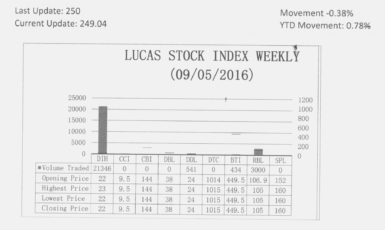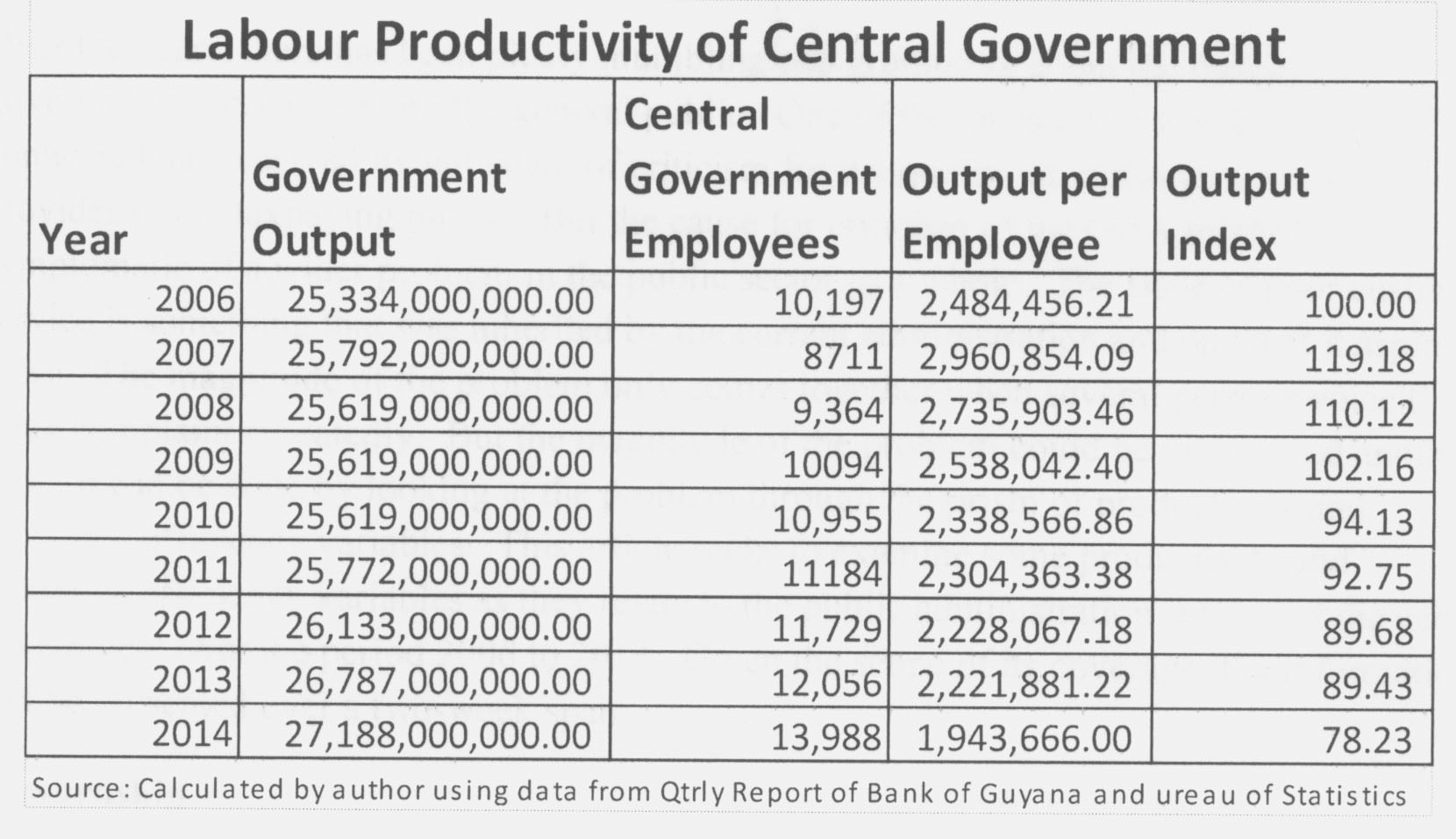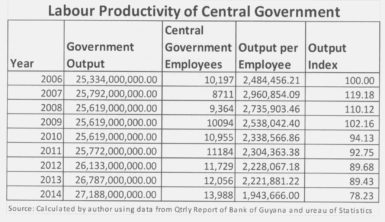Mumbling and grumbling
Over the years, there has been plenty mumbling and grumbling about the quality of government services among the general public. One of the agencies to which this writer is connected has received its fair share of criticism for the quality of customer service that it provides to the taxpaying public. But the cause for criticism of the Guyana Revenue Authority might be symptomatic of a wider problem in the public sector as a whole. The issue of poor customer service is something that was inherited by the current administration and one that it aspires to solve. The magnitude of the problem only comes together when several persons voice the same complaint repeatedly. But the magnitude of the problem could be understood another way. It can be done by looking at the problem through the prism of productivity and economic efficiency variables. This article seeks to examine some productivity and economic efficiency variables as they relate to the public administration service of the central government over the period 2006 to 2014. Given the scope of its coverage, the information will be presented over a two-week span.
 Stewardship
Stewardship
An inquiry of this nature is important because the Guyana economy exhibited consistent growth from 2007 to 2013. Yet, that success has not translated into significant changes in the quality of life of citizens and any evidence of confidence in the government services during the period of review. The economic success, despite being limited in its distribution, is often attributed to good stewardship by the government and not to anything or anyone else despite the existence of a private sector. Indeed, the government of the day is often given the blame for anything that goes wrong and usually seeks the praise for all the good that happens in the country. At least so it was with the previous government. It is reasonable therefore to examine the last government’s performance to see if it deserves the accolades that it heaps upon itself for the sustainability and rate at which the economy grew under the period in review.
This examination would be done by assessing the productivity levels of various inputs that are critical to the delivery of the service performed by government. The key metric would be current expenditure by government under certain expenditure categories. The expenditure categories are labour, equipment and supplies, fuel and lubricants, rental and maintenance of buildings, electricity charges, and transport and travel. The output would be the contribution of public administration to the gross domestic product (GDP) of the country.
Market failure
Government spending is often justified on the basis of market failure. Government intervention is seen as a saviour by providing goods and services where the private investor will not provide much needed essential goods or services. People are sympathetic to the decisions of government when they can see the benefit of the decision to produce a certain set of goods or services. An essential service of government is that of making the people of a country safe and secure. Therefore, Guyanese see value in the work of the police and the judiciary, even though they are left disappointed by both services in many instances. Good sanitation and well-maintained roads, good health and good education were all seen as important services of central government. Given the dismal service of the police and judiciary, the deplorable condition of the environment, the poor state of the roads and the frequency of maternal deaths, the previous administration developed a reputation for being reckless with the money of taxpayers.
It is essential to understand the difference between productivity and economic efficiency since both concepts deal with the relationship between output and inputs. Also, they both deal with changes in performance of the inputs. The difference is that the input/output relationship in productivity is measured within a given unit of time whereas economic efficiency does not always depend on the unit of time. For example, the output of one unit of labour within one hour gives rise to a measure of productivity. The time period is not always important when measuring efficiency. If one could increase revenues by incurring the same amount of cost, then one could talk about the efficiency of operations improving. Productivity tends to measure physical output while efficiency measures both physical and qualitative changes in performance. The concept of efficiency therefore tells one much more about the performance of an economic unit than productivity. For example, it tells one that something acted upon the input to make it better. In some cases that added force could be new technology or a change in work habits or attitude.
Allocation of resources
At the level of government, economic efficiency is about the allocation of resources to improve economic welfare. Without going into technical details of the issue, it would be important to note that government spending itself reflects allocation among priorities. More emphasis could be placed on health as against education. Or it could be a case where greater emphasis is placed on safety and security as against creating a sustainable environment. The allocation of government spending is therefore an important indicator of government efficiency. The expectation that Guyanese would have is that good performance by the government would be revealed in the same amount of output of goods and services while using a smaller amount of inputs. Or, it could be seen as achieving more output of goods and services with the same amount of input. Whichever way it is looked at, the important thing is that the relationship between inputs and output changes in a favourable manner.
This writer has selected six items of expenditure which ought to help readers understand the extent to which the previous government was not delivering services as it should. The first item that will be considered is that of labour productivity. This measurement utilizes the output described as public administration. This figure is equivalent to the amount of goods and services produced by the central government and is indicative of the work done by the people working in the central government. The output is based on the actual number of persons reported by the Bureau of Statistics as working for the central government for a given year. The case is based also on the assumption that expenditure on all other variables is held constant while the expenditure on labour is allowed to vary from 2006 to 2014. What that means then is that labour productivity could have been enhanced by better use of other variables used in the production process.
TABLE 1
Table 1 above shows what happened to labour productivity from 2006 to 2014. Output per employee kept falling even though government output kept rising. The addition of more employees was not necessarily improving the efficiency or productivity of the government. The output index reveals that the best performance was achieved in 2007 after which the output of the central government employees began to decline. While additional work needs to be done, the output index points to a problem of worker productivity.
(To be continued)
 The Lucas Stock Index (LSI) declined 0.38 percent during the first period of trading in September 2016. The stocks of four companies were traded with 25,321 shares changing hands. There were no Climbers and one Tumbler. The stocks of Republic Bank Limited (RBL) fell 1.78 percent on the sale of 3,000 shares. In the meantime, the stocks of Banks DIH (DIH), Demerara Distillers Limited (DDL) and Guyana Bank for Trade and Industry (BTI) remained unchanged on the sale of 21,346, 541and 434 shares respectively.
The Lucas Stock Index (LSI) declined 0.38 percent during the first period of trading in September 2016. The stocks of four companies were traded with 25,321 shares changing hands. There were no Climbers and one Tumbler. The stocks of Republic Bank Limited (RBL) fell 1.78 percent on the sale of 3,000 shares. In the meantime, the stocks of Banks DIH (DIH), Demerara Distillers Limited (DDL) and Guyana Bank for Trade and Industry (BTI) remained unchanged on the sale of 21,346, 541and 434 shares respectively.






